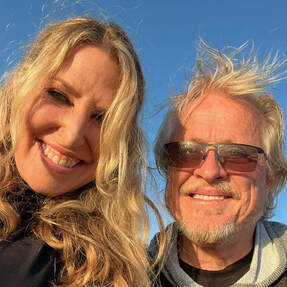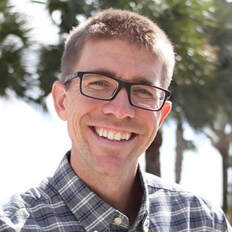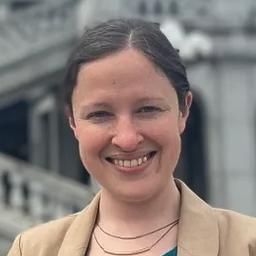
Dr. Steve McDaniel and Beth McDaniel, JD founded and run Reactive Surfaces, and intellectual property firm that develops and patents paints that do more than turn buildings attractive colors and protect them from the elements: They react to the atmosphere in intentional and desirable ways. They are currently in the running to win the most valuable X-Prize contest ever by creating a paint that captures CO2 from the atmosphere more simply, cheaply and scaleably than any direct air carbon technology before it.
The McDaniels founded Reactive Surfaces in 2001 in response to the events of 911. They wanted to know if they could stabilize an enzyme in a coating to protect surfaces against a chemical weapons attack. This original technology is called WMDtox, and it works to decontaminate organophosphorous nerve gases virtually on contact. From there, they have developed other various functional platform technologies using non-toxic bio-based organisms, such as self-cleaning coatings and coatings that are antimicrobial and antiviral. Carbon Capture Coatings have the power to significantly reduce carbon dioxide in the atmosphere, thereby lessening the impact of global warming. Carbon Capture Coatings are bio-engineered such that, when exposed to sunlight, they capture and fix atmospheric carbon dioxide. These coatings support living cells capable of carrying out photosynthesis, the process by which Nature captures and fixes atmospheric CO2. Further Reading: · Carbon Capture Coatings: Next Generation Biomimetic Coatings for Carbon Capture & Removal · Carbon Capture Coatings: Can Paints and Coatings Save Humanity? Support the show 
Hurricane Ian rocked southwest Florida with all the damage and years of rebuilding in plain sight on our television screens. It is becoming obvious that this is not the last of huge killer hurricanes as the waters of the Gulf of Mexico and other large bodies of water heat up. Southwest Florida is planning to rebuild with scientists and city planners exploring ways to make towns more resilient for the next hurricane. They should start by looking at a planned community right in their backyard called Babcock Ranch who survived a direct hit yet roofs stayed on, there was minimal flooding, and the electricity never failed. Ryan Foelske a Carbon Free Electricity Program manager at RMI (previously the Rocky Mountain Institute) decided to put his money where his mouth is by buying a home in Babcock Ranch, a community designed to both reduce human contribution to climate change and to be more resilient to the effects of climate change, especially hurricanes. He tells us about his experience weathering hurricane Ian. Prior to joining RMI, Ryan worked at Deutsche Bank and Brookfield Asset Management as a buy-side equity analyst specializing in global regulated utilities and other publicly listed infrastructure companies. He built financial models, understood and quantified risks, and sought benchmark-beating returns for investors. In addition to his company coverage duties, Ryan helped develop the modeling framework, standardized and aggregated data outputs, and worked on index construction and inclusion. As we discuss in the episode, resilience is an area of extensive funding under the Infrastructure Investment and Jobs Act and the Inflation Reduction Act. Babcock Ranch has not received any funding under these pieces of federal legislation. Nevertheless we think its resilience measures are worth considering as background for other projects that may receive such funding in the future. For more information... 
While pollution mitigation and control is vital to the environment, scientists are finding more and more problems for the humans that live near polluting corporate sites. Unfortunately in the name of jobs and profit, companies have produced pollution while ignoring or hiding the human health from their work, often producing what is known as "sacrifice zones" -- areas where the pollution is dangerous for people who often cannot leave. The Environmental Health Project has taken on the difficult job of using health science discern the short and long term effects of gas fracking and plastic production on local populations. On this podcast episode, we welcome Alison Steele, who tells us the good, the bad and the ugly of trying to help communities protect their health from the perils of corporate practices that could affect these communities for generations. Alison L. Steele, MBA, is the Executive Director of The Environmental Health Project (EHP), a nonprofit public health organization that assists and supports residents of Southwestern Pennsylvania and beyond who believe their health has been, or could be, impacted by shale gas development and other polluting industries in the area.. Alison earned her undergraduate degree in physics from Drew University in Madison, NJ and her MBA in Sustainable Business Practices from Duquesne University in Pittsburgh, PA. As part of her graduate work, Alison studied sustainability tools and practices used by leading companies in Europe, performed consulting services for large Pittsburgh-area companies, and published research on organizational behavior techniques used to aid adoption of sustainability initiatives. Prior to starting at EHP, she led policy and education efforts at Conservation Consultants, Inc. and developed the company's flagship grassroots community engagement program, which focused on advancing home health and energy efficiency in low-income Pittsburgh neighborhoods. She joined EHP at the beginning of 2020, and since then, she and her team have been taking advantage of our increasingly virtual world to extend their reach as they work to defend public health in the face of shale gas development. Some links for further reading:
|
AuthorsDina Rasor Archives
June 2024
Categories |
© 2021 Climate Money Watchdog Inc., a Project of the Media Alliance, a tax-exempt 501(c)(3) Charitable Organization
 RSS Feed
RSS Feed